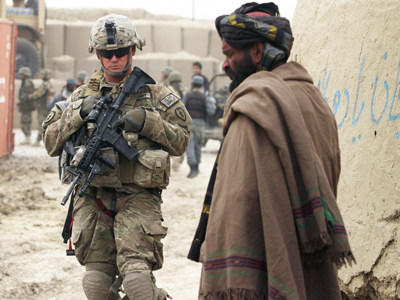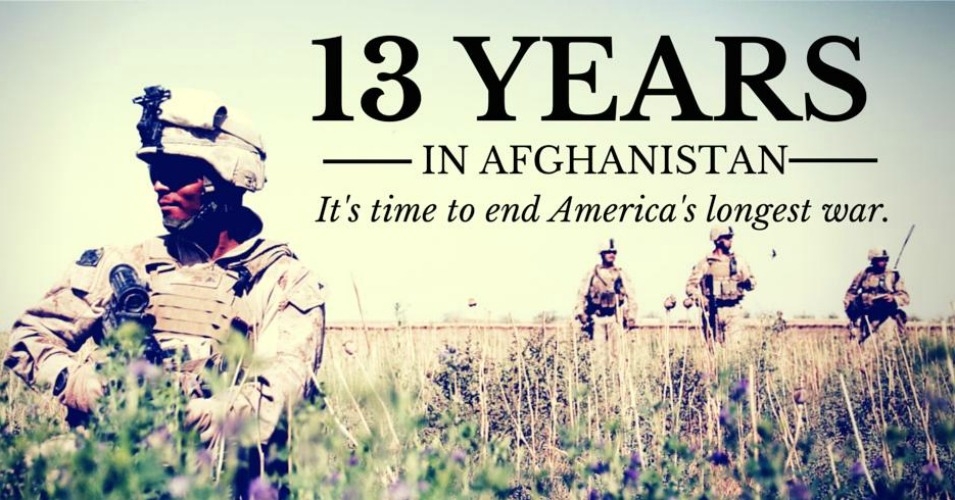After 13 Years, it’s Time to End the Endless War in Afghanistan
As 'longest war' hits another milestone, human costs continue to rise

As the U.S. expands its air bombardment of Iraq and Syria, Tuesday marks another milestone for a nation at war: the 13th anniversary of the U.S.-led invasion of Afghanistan, the longest officially recognized war in U.S. history.
“One of the dangers around the ongoing war in Afghanistan is that people have wanted it to end for years, so it’s as though we wished it away some time ago,” Peter Lems, Program Officer at the American Friends Service Committee, told Common Dreams. “Yet it hasn’t gone away. I think the real challenge is to acknowledge the true cost of this war.”
Win Without War is urging people across the United States to mark this anniversary by telling President Obama “it’s time to end our endless war in Afghanistan.” Furthermore, veterans and their allies plan to gather at the Vietnam Veterans Memorial Tuesday evening to call for an end to the war in Afgahnistan and honor lives lost to combat and trauma. Organizers with the Philadelphia Interfaith Network Against Drone Warfare will hold afilm screening and conversation Tuesday marking the date.
Community organizations from Rhode Island to North Carolina to Indianapolis plan to hold memorials and actions throughout the week calling for an end to the war in Afghanistan and a shift away from endless war more broadly, said Lems.
The anniversary of the U.S.-led invasion comes just a week after the U.S. and Afghanistan signed theBilateral Security Agreement, which paves the way for at least another decade of U.S. military presence in Afghanistan. The provisions of the pact include: ongoing U.S. training, funding, and arming of the Afghan military; an extension of immunity to U.S. service members under Afghan law, and a green-light to keep thousands of U.S. troops beyond what President Obama calls the “end of the U.S. combat mission” at the conclusion of 2014. Furthermore, NATO’s status of forces agreement, also signed last month, grants similar privileges to thousands of foreign troops now slated to remain in Afghanistan past the end of this year.
The anniversary of the U.S.-led invasion comes just a week after the U.S. and Afghanistan signed the Bilateral Security Agreement, which locks in at least another decade of U.S. military presence in Afghanistan. (Photo: Win Without War)
“Another decade-long extension is not the answer to 13 years of failed war,” said Suraia Sahar of Afghans United for Justice in an interview with Common Dreams. “The definition of insanity is doing the same thing over and over again and expecting different results. As long as there is a foreign occupying force in the country, Afghans will continue to reject it.”
There are approximately 40,000 NATO troops currently stationed in Afghanistan, the vast majority of them American. Obama has previously stated he plans to keep thousands of U.S. troops in Afghanistan after the end of this year, with plans to cut numbers to 9,800 by the beginning of 2015, and instate further reductions at the end of next year, as well as in 2016. In addition, thousands of troops from other NATO countries will remain, with 12,000 total foreign troops slated to remain after the end of this year, U.S. Central Commandreports.
Afghan civilians continue to pay a staggering price. A report released in July by the United Nations Assistance Mission in Afghanistan notes that Afghan civilian deaths and wounds as a result of the fighting have steadily risen since 2012 and are overall higher than they were in 2009. From January 1 to June 30, 2014 alone, approximately 4,853 civilians were killed, a 24 percent increase over the same months in 2013. This heavy toll has been punctuated with high-profile massacres, including the Panjwai massacre, in which 16 Afghan civilians were gunned down and killed and 6 more wounded by U.S. Army Staff Sgt. Robert Bales.
The costs of this war, which is considered the longest official war—not including unacknowledged U.S. wars, as well as wars that extended beyond their formal end-dates—extend far beyond these grim numbers. The human toll includes long-term effects of social destabilization and militarization, political and military dependency on the United States, and starvation, poverty, erosion of vital public infrastructure, and mass displacement.
In addition, approximately 3,475 international troops have died in he war, 2,334 of them U.S. service members. The latter figure, provided by the Department of Defense, does not take into account the long-term wounds, including trauma, that continue to take life after service members are discharged from the military.
“It’s a long war, and it’s going to keep setting the record, as the U.S. plans to extend the war to 2024,” Brock McIntosh, an Afghanistan veteran and conscientious objector who is a member of Iraq Veterans Against the War and works with the Afghan Peace Volunteers, told Common Dreams. “Like most modern wars, more civilians have died than American soldiers or Afghan fighters, and civilians are continuing to die.”


